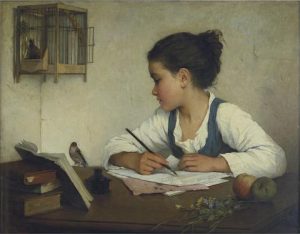 In which I interview myself on National Novel Writing Month (NaNoWriMo)
In which I interview myself on National Novel Writing Month (NaNoWriMo)
What are you doing National Novel Writing Month* this year, Deborah?
Cheering on my friends. I’ll be finishing up revisions on the next Darkover novel, Arilinn. Revising is a very different process from drafting. I find that drafting goes better when I do it quickly, so I don’t get caught in second-guessing myself or editing as I write. Both are recipes for disaster and paralysis. Revising, on the other hand, does not reliably produce any measurable result in terms of pages or words. I dive into it and call it quits every day when my brain won’t function any longer.
How does NaNoWriMo compare to real writing?
Writing is writing! Every writer does it a little differently, and I think most of us change from project to project and also over the course of our careers. Challenges, whether novel-length or short-length, can be fun or oppressive, pointless, or a marvelous way to jump-start a new story.
Doesn’t it bother you when hundreds of thousands of people every year turn your career, the dream job you’ve worked at for 16 years, into some kind of game?
You say “game” as if it’s a bad thing. If some aspect of writing isn’t fun — and there are wonderful professional writers who hate to write but love to have written — then why do it? The community-building that happens during NaNoWriMo is one of its more attractive aspects. Writing is a solitary activity, so it’s wonderful to have those “hundreds of thousands” of compadres cheering you on.
Sorry. Do you think it’s possible to write a good novel in 30 days?
Yes and no. Some writers can produce a solid first draft in a month, so that’s the yes part. On the other hand, I’m skeptical of any first draft, no matter how long it takes, being “a good novel.” I suppose some writers do so much planning and so much reflection on each sentence that their first drafts-on-paper are really third-drafts-in-the-mind. In the end, though, the goal is not to produce a good novel but to write quickly and and consistently and to push through to the end.
Isn’t the emphasis on quantity over quality a bad thing, teaching participants to write crap?
Most writers don’t need to be taught how to write crap. We do that very nicely all on our own, thank you. However, writing challenges can teach us to get the story down on paper (or phosphors), which is a necessary first step to a polished final draft. The rewards of actually finishing a novel draft, no matter how much revision it will need, should not be underestimated. Even if that novel is indeed crap, it is finished — the writer now knows that he or she is capable of completing it. That in itself is worth celebrating.
Another thought on crap. If you aren’t writing it and you never have, you aren’t doing your job. You aren’t taking chances or pushing edges or just splatting out what’s in the back of your semi-conscious mind. You are allowing your inner critic to silence your creative spirit.
Eric Rosenfield says NaNoWriMo’s whole attitude is “repugnant, and pollutes the world with volumes upon volumes of one-off novels by people who don’t really care about novel writing.“
I seriously doubt that what is wrong with this world is the surfeit of aspiring novelists. And I can’t imagine why anyone would put herself through NaNoWriMo if she didn’t ‘care about novel writing.’ Good grief, if you want to be irate about Bad Things In The World, there are plenty of issues out there, things that actually impact people’s health, liberty, and lives. Too many one-off novels is not one of them.
Can storytelling be taught? I’m not sure. Yep to the other parts.
Fine, what do you think NaNoWriMo is about?
Why is it about anything than a community of people hell-bent on crash’n’burning their way through a short novel in a month? That makes more sense than it being a nefarious conspiracy.
Any last words of advice, Ms. Very Important Author?
I’d love there to be a parallel track for those of us who have other deadlines, such as revisions or finishing in-progress novels. Certainly FiMyDaNo (Finish My Damned Novel) fits the bill, and I encourage anyone in mid-draft to jump in. Revisions, at least mine, mean taking notes, cogitating, making flow charts of structure, correcting maps, ripping out chunks and shoving them around, not to mention generating piles of new prose. These all count. The thing with revisions is that sometimes a lot of thinking and a small amount of actual wordage change — if it’s the right change — counts for a solid day’s work. It’s exhausting, too. So maybe the goal is, “I will think about my revisions every day this month.”
Okay, Ms. Interviewer, if you’re not doing NaNoWriMo, what are your goals for this month?
*November 1 – November 30

 Somewhere fairly recently I was in a conversation with someone (can you tell I cannot for the life of me remember when, or with whom, the conversation occurred?) about the why of writing. The person I was talking with spoke pretty definitively about why writers write, and while her points (I can remember it was a woman I was speaking with, maybe by the time I finish this post I’ll remember her name) were valid, I thought they were also limited. As if she could not imagine reasons to write that were not hers. Which is the crux of why I write. I’m trying to figure out why people do what they do. It’s why I read, too: to understand.
Somewhere fairly recently I was in a conversation with someone (can you tell I cannot for the life of me remember when, or with whom, the conversation occurred?) about the why of writing. The person I was talking with spoke pretty definitively about why writers write, and while her points (I can remember it was a woman I was speaking with, maybe by the time I finish this post I’ll remember her name) were valid, I thought they were also limited. As if she could not imagine reasons to write that were not hers. Which is the crux of why I write. I’m trying to figure out why people do what they do. It’s why I read, too: to understand.